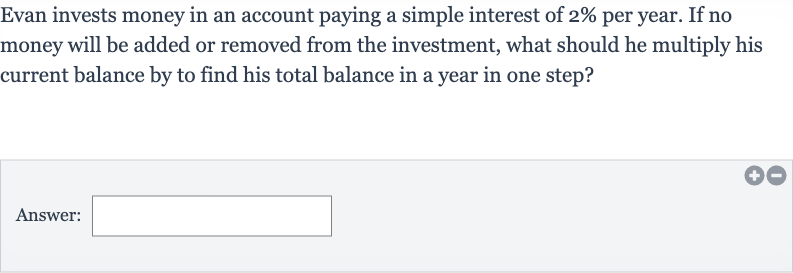AI tutor
Welcome to Bytelearn!
Let’s check out your problem:

Evan invests money in an account paying a simple interest of per year. If no money will be added or removed from the investment, what should he multiply his current balance by to find his total balance in a year in one step?Answer:
Full solution
Q. Evan invests money in an account paying a simple interest of per year. If no money will be added or removed from the investment, what should he multiply his current balance by to find his total balance in a year in one step?Answer:
- Calculate Simple Interest: To find the total balance after one year with simple interest, we need to calculate the interest earned and add it to the original balance. The formula for simple interest is , where is the interest, is the principal amount (initial investment), is the annual interest rate (as a decimal), and is the time in years.
- Convert Annual Rate to Decimal: Since Evan's annual interest rate is , we convert this percentage to a decimal by dividing by . So, .
- Determine Time Period: The time is year, as we are looking for the total balance after one year.
- Calculate Interest Earned: Now, we can calculate the interest earned in one year. Using the formula , we get .
- Calculate Interest Amount: The interest earned in one year is of the principal amount, which means Evan should multiply his current balance by to find the interest earned.
- Find Total Balance: To find the total balance, Evan needs to add the original principal amount to the interest earned. This means he should multiply his current balance by (to account for the original balance) and then add the interest earned ( of the balance). So, the total balance can be found by multiplying the current balance by ().
More problems from Find the percent: tax, discount, and more
QuestionGet tutor help
QuestionGet tutor help
QuestionGet tutor help
QuestionGet tutor help
QuestionGet tutor help
